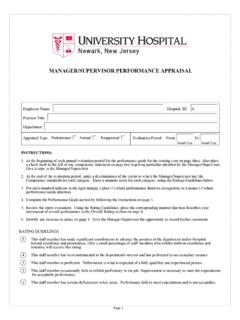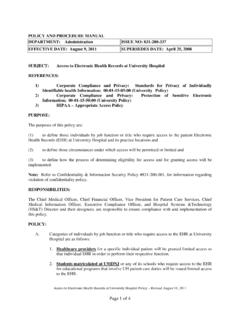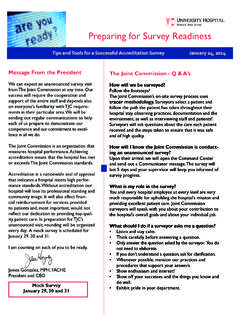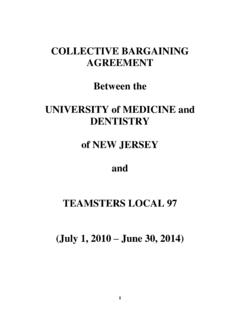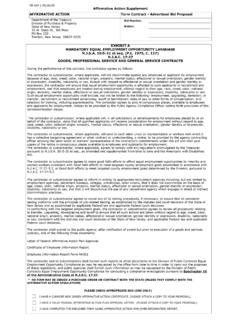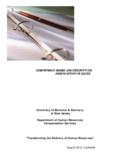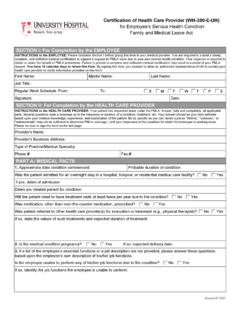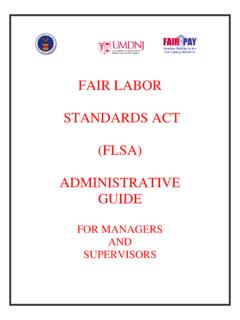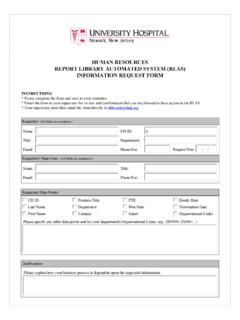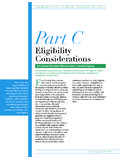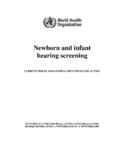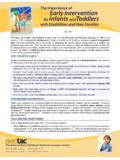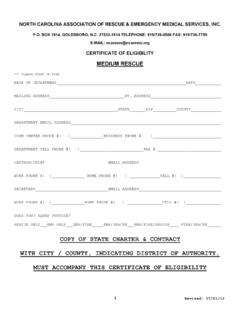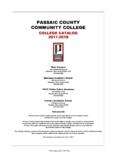Transcription of Preparing for Survey Readiness - University Hospital
1 March 31, 2014 Tips and Tools for a Successful Accreditation SurveyPreparing for Survey ReadinessPATIENT ASSESSMENT Patient Assessment is a key issue which will be in-vestigated by The Joint Commission when they sur-vey our Hospital . Let s review this important is Patient Assessment?Patient Assessment means taking all the necessary steps to evaluate the patient upon admission. The routine Hospital evaluation of a patient works logi-cally through history-taking, physical examination, gathering of laboratory data, confirmation of a diagnosis and initiation of treatment. Patient Assessment also includes: plan-of-care, treatment and services; ongoing reassessment of care; discharge planning, referral for continuing care, or the discontinuation of services. When is the initial in-patient-nursing assessment completed?
2 This is completed within 24 hours of are patients reassessed? Patients are reassessed at every shift, when there is a change in the clinical condition or upon transfer to another level of PainPain effects the whole person - physically, emotion-ally and spiritually. That s why treating pain is a very important part of good patient care. Remember! It is the policy of University Hospital to respect and support the patient s right to optimal pain assessment and are some important questions and answers related to pain management at University Hospital . When is PAIN initially assessed?An initial comprehensive pain screening is completed during the ad-mission process or first outpatient visit. We want to know what type of pain the patient is experiencing, whether it is acute or chronic and what their comfort goal related to pain may include, but are not limited to: Location of pain Onset of pain Intensity of pain Frequency of pain Type of pain Cultural implications Other symptoms associated with pain What makes pain better /worse Any pain relief methods that have been effective Patients pain goalWhen should PAIN be reassessed?
3 At every shift Whenever a patient indicates they have new or unrelieved pain Following an intervention for pain Change of condition DischargePain reassessment will occur within a reasonable time frame based on the actions of the medication and route of administration. A. Reassessment includes intensity rating, scale used and any adverse effects. B. Patients that appear to be sleeping when it is time to perform a reassessment will have a respiratory assessment per-formed. If respirations are within normal limits, pain assessment can be delayed until the patient awakens; appears to be sleep-ing can be documented. If respiratory depression is noted, wake the patient, reassess and notify the physician. C. If the patient s pain is above the comfort / function goal despite interventions, the physician is to be notified.
4 If the patient has pain that is unable to be controlled, a Pain Manage-ment Service consult may be requested by the attending looks awful and leaves tape residue which the surveyors site us on. If you have something to hang, laminate it or use a plastic cover, then affix it with Velcro or 2-sided tape. Paper breeds germs! Give it the boot! Don t Tape ANYTHING to Walls!How are patients educated on PAIN at discharge?Patients will be educated on pain management at discharge in the following ways: Therapeutic pain relief methods to maintain comfort Medication use, route, frequency, contraindications and side-effects of medications Symptom management Contact information for continued pain management How do we assess PAIN? University Hospital uses a variety of tools to rate pain. Here are some: Numeric Pain Intensive pain on a scale of 0-10.
5 Faces is used for children three years and older. It is also used for any patient who is non-English speaking, has limited communication skills, is cognitively impaired, or is unable to understand the numeric pain intensive scale. FLACC is used for children ages 2 months to 7 years, who are cognitively intact. NIPS Scale (Neonatal Infant Pain Scale)..is used for patients birth to one year. It measures facial expression, crying, breathing patterns, arms, legs, and state of arousal. Detroit Medical Center / PABS (Pain Assessment Behav-ioral Scale). Patients that are intubated cannot use this scale. Where can the caregiver find pain documentation? The caregiver will find pain documentation and re-assess-ments in the medical record. They should be familiar with its location and ensure that re-assessments are docu-mented within the time frame required by mechanism is in place to alert the physician for PAIN problems?
6 Nurses assess pain and should call the doctor whenever it is an issue. Who is the best indicator of pain? The patient. Self-reported pain is the best method of assessment. How can we help patients talk about their pain? Patients don't want to be viewed as a "complainer . That s why patients should be ENCOURAGED to ask for pain relief, whenever they are in pain. The sooner they speak up, the better. It is easier to control pain in its early stages, then before it becomes Abuse or NeglectAs an employee of University Hospital , there may be times when you come into contact with a patient who may show signs of possible abuse or neglect. What is abuse?Abuse is physical, sexual, or emotional harm or risk of harm to an individual caused by anyone, including a parent or person who acts as a is neglect?
7 Neglect occurs when a parent or caregiver fails to provide proper supervision, adequate food, clothing, shelter, education or medical care although financially able or assisted to do is abuse of a vulnerable or elder adult?Abuse of a vulnerable or elder adult is when physical, psychological, sexual or financial harm is brought to a vulnerable/elderly adult. Caregiver neglect occurs when the vulnerable/elderly adult s basic needs are not being provided for patients are assessed for signs and symptoms of abuse and neglect?All patients are assessed for signs of abuse and neglect during the admission assessment. In the ambulatory areas, staff members evaluate patients during each a staff member observes or has reason to suspect abuse or neglect, what should he/she do?Address the problem immediately.
8 Report your con-cerns to your supervisor and request a Social Work consultation so that the issues are explored and reported to the appropriate authorities. Social workers are available from 8:00 am to 5:00 pm. The department can be contacted at extension 2-5842. In the evenings and weekends, the Social Work pager number is 973-421-0881. After hours the Social Work manager may be reached at 973-715-9022. If child abuse or neglect is suspected a call is made to the Division of Child Protection and Permanency (DCPP) which provides a 24 hour emergency hotline 877-652-2873. The call may be made by the social work-er, physician or by/on behalf of a physician or adminis-trator of the Hospital . If elder abuse or abuse of a vulnerable adult is suspected, a social worker will do an assessment and take steps to identify and put in place those services that can help protect the vulnerable adult.
9 If the patient is returning home, the social worker will place a call to Adult Protective Services, 973-624-2528, X135,upon discharge. Assessing Rehabilitation NeedsWhen should a rehabilitation consult be considered?A rehabilitation consult should be considered when a patient presents with new impairments in function where they now require assistance and their ability to return to pre-admission functional status becomes limited. Functioning in areas such as: mobility, toileting, feeding, bathing, ambulation, swallowing, and communication should be : Any person who in good faith, makes a report of child abuse or neglect or testifies in a child abuse hearing resulting from such a report is immune from any criminal or civil liability as a result of such action. Preparing for Survey Readiness is produced by the Public Affairs Department.
10 For questions or contributions, please contact Kitty Donohue at 2-2365 or one anotherand our patientswith Practices at University HospitalAdopted by the UH Patient Safety Committ

